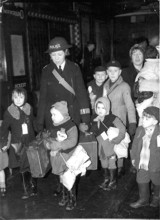The Blitz
The term ‘the Blitz’ comes from the German word Blitzkrieg (lightning war) which was used to describe the German invasions of European countries in the early stages of the Second World War. In the British context the term is generally used to describe the air raids of 1940, though air raids continued throughout the war and, in the final months of the conflict, involved the use of the V1 flying bombs and V2 rockets.
There was a fear that gas bombs would be dropped in air-raids rather than high explosive or incendiary bombs. Gas had, after all, been used on the battlefield during the First World War. People were expected to carry their gas masks with them when they went out in case of a raid.
Documents
- A photograph of a Woman Police Officer and evacuee children in London.
- A photograph of a Police Sergeant and Woman Police Sergeant demonstrating civilian gas masks outside Harrow Road Police Station, London.
- A photograph of a policeman issuing the ‘Take Cover’ order in London.
- Fred Fancourt’s recollection of driving a police ambulance during an air-raid in Birmingham.
- A photograph of Fred Fancourt and Birmingham City Police Officers
with a police ambulance.
(Fred Fancourt was born in Lincolnshire and had begun his working life in a garage. In 1929 he joined the Birmingham City Police.) - A photograph of a woman being carried from a bombed building on a stretcher in London.
- A photograph of Sergeant Robson in London.
- A photograph of Sergeant Fred Greenstreet, in the centre of the picture, directing rescue workers. The men surrounding him with the steel helmets and the figure behind with the beret, are civil defence rescue workers. The photograph shows the aftermath of a raid by FW190 fighter bombers on 20 January 1943 when bombs fell on Sandhurst Road School at Catford in South East London. Sergeant Greenstreet had two sons at the school; one of the two, aged 8 years, was killed in the raid.)
- A photograph of a ‘Beware of the Butterfly Bomb’ poster.
- A photograph of a City of London constable patrolling his beat after an air-raid.
- Metropolitan Police Orders, 4 September 1939: Action to be taken by drivers in an air-raid. See the notes below.
- Metropolitan Police Orders, 18 September 1939: Air raid warnings, etc.
- Metropolitan Police Orders, 30 September 1940: Roll of Honour, etc.
- The report in The Times, 21st January 1943, of the raid that caused the damage shown in the photograph above with Sergeant Fred Greenstreet. See the notes below.
- A report in The Times, 22nd January 1943, of the rescue operation.
Notes
Metropolitan Police Orders were daily instructions issued by the Commissioner of the Metropolitan Police to his men. Printed copies were distributed to each police station in London. They cover a range of topics from the arrangements for public meetings or demonstrations, to commendations, promotions and disciplinary matters. Back.
The above documents are a good example of the type of material used by historians for their research. The students could be asked to think about where they might find such material. Model answers should include: local studies centre (usually in the local and/or county town library), county record offices, The National Archives (TNA), Kew, specialist archives, the British Library and other specialist libraries. Back
The Blitz
